 |
 |
Our enthusiastic and extremely knowledgeable perennials team is here to answer your questions and help you choose the best perennials for your situation. There’s always something in bloom for sun, shade, butterflies, birds or deer resistance as well as a variety of bulbs for your space.
Stroll through our time-tested favorites and introduce yourself to the newest varieties. We garden with perennials too; we love them and it shows!
|
29 found, showing page 1 of 2
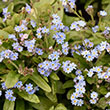
Small, blue flowers bloom in abundance. Dense, mounded habit. USDA 3-9
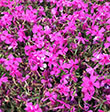
Height: 5 inches
Spacing: 15 inches
Sunlight: full sun, partial shade
Hardiness Zone: 2a
Other Names: Drummond Pink Phlox, Creeping Phlox
Description:
This variety produces a dazzling display of large, hot pink flowers that blanket the plant in spring; prune lightly after flowering to encourage a dense growth habit; wonderful for rock gardens, edging, or in mixed containers
Ornamental Features:
Drummond's Pink Moss Phlox is smothered in stunning hot pink star-shaped flowers at the ends of the stems from early to late spring. Its tiny needle-like leaves remain forest green in color throughout the year.
Landscape Attributes:
Drummond's Pink Moss Phlox is a dense herbaceous evergreen perennial with a ground-hugging habit of growth. It brings an extremely fine and delicate texture to the garden composition and should be used to full effect.
This plant will require occasional maintenance and upkeep, and should only be pruned after flowering to avoid removing any of the current season's flowers. It is a good choice for attracting bees, butterflies and hummingbirds to your yard, but is not particularly attractive to deer who tend to leave it alone in favor of tastier treats. Gardeners should be aware of the following characteristic(s) that may warrant special consideration:
- Spreading
Drummond's Pink Moss Phlox is recommended for the following landscape applications:
- Mass Planting
- Rock/Alpine Gardens
- Border Edging
- General Garden Use
- Groundcover
Planting & Growing:
Drummond's Pink Moss Phlox will grow to be only 4 inches tall at maturity, with a spread of 18 inches. When grown in masses or used as a bedding plant, individual plants should be spaced approximately 15 inches apart. Its foliage tends to remain low and dense right to the ground. It grows at a medium rate, and under ideal conditions can be expected to live for approximately 10 years. As an evegreen perennial, this plant will typically keep its form and foliage year-round.
This plant does best in full sun to partial shade. It prefers dry to average moisture levels with very well-drained soil, and will often die in standing water. It is considered to be drought-tolerant, and thus makes an ideal choice for a low-water garden or xeriscape application. It is not particular as to soil type, but has a definite preference for alkaline soils. It is highly tolerant of urban pollution and will even thrive in inner city environments. Consider covering it with a thick layer of mulch in winter to protect it in exposed locations or colder microclimates. This is a selection of a native North American species. It can be propagated by division; however, as a cultivated variety, be aware that it may be subject to certain restrictions or prohibitions on propagation.
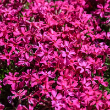
Height: 6 inches
Spacing: 15 inches
Sunlight: full sun, partial shade
Hardiness Zone: 2a
Other Names: Creeping Phlox
Ornamental Features:
Scarlet Flame Moss Phlox is smothered in stunning lightly-scented scarlet star-shaped flowers at the ends of the stems from early to late spring. Its tiny needle-like leaves remain green in color throughout the year.
Landscape Attributes:
Scarlet Flame Moss Phlox is a dense herbaceous evergreen perennial with a ground-hugging habit of growth. It brings an extremely fine and delicate texture to the garden composition and should be used to full effect.
This plant will require occasional maintenance and upkeep, and should only be pruned after flowering to avoid removing any of the current season's flowers. Deer don't particularly care for this plant and will usually leave it alone in favor of tastier treats. Gardeners should be aware of the following characteristic(s) that may warrant special consideration:
- Spreading
Scarlet Flame Moss Phlox is recommended for the following landscape applications:
- Mass Planting
- Rock/Alpine Gardens
- Border Edging
- General Garden Use
- Groundcover
Planting & Growing:
Scarlet Flame Moss Phlox will grow to be only 6 inches tall at maturity, with a spread of 18 inches. When grown in masses or used as a bedding plant, individual plants should be spaced approximately 15 inches apart. Its foliage tends to remain low and dense right to the ground. It grows at a medium rate, and under ideal conditions can be expected to live for approximately 10 years. As an evegreen perennial, this plant will typically keep its form and foliage year-round.
This plant does best in full sun to partial shade. It prefers dry to average moisture levels with very well-drained soil, and will often die in standing water. It is considered to be drought-tolerant, and thus makes an ideal choice for a low-water garden or xeriscape application. It is not particular as to soil type, but has a definite preference for alkaline soils. It is highly tolerant of urban pollution and will even thrive in inner city environments. Consider covering it with a thick layer of mulch in winter to protect it in exposed locations or colder microclimates. This is a selection of a native North American species. It can be propagated by division; however, as a cultivated variety, be aware that it may be subject to certain restrictions or prohibitions on propagation.
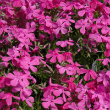
Deep pink blooms. Evergreen groundcover. Native. USDA 3-8
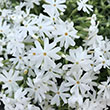
Plant Height: 4 inches
Flower Height: 6 inches
Spacing: 15 inches
Sunlight: full sun, partial shade
Hardiness Zone: 2a
Other Names: Creeping Phlox
Description:
This variety produces a showy carpet of bright white flowers shining in the spring sun; prune lightly after flowering to encourage a dense growth habit; wonderful for rock gardens, edging, or in mixed containers
Ornamental Features:
Snowflake Phlox is smothered in stunning white star-shaped flowers with buttery yellow eyes at the ends of the stems in late spring. Its tiny needle-like leaves remain forest green in color throughout the year.
Landscape Attributes:
Snowflake Phlox is a dense herbaceous evergreen perennial with a ground-hugging habit of growth. It brings an extremely fine and delicate texture to the garden composition and should be used to full effect.
This plant will require occasional maintenance and upkeep, and should only be pruned after flowering to avoid removing any of the current season's flowers. Deer don't particularly care for this plant and will usually leave it alone in favor of tastier treats. Gardeners should be aware of the following characteristic(s) that may warrant special consideration:
- Spreading
Snowflake Phlox is recommended for the following landscape applications:
- Mass Planting
- Rock/Alpine Gardens
- Border Edging
- General Garden Use
- Groundcover
Planting & Growing:
Snowflake Phlox will grow to be only 4 inches tall at maturity extending to 6 inches tall with the flowers, with a spread of 18 inches. When grown in masses or used as a bedding plant, individual plants should be spaced approximately 15 inches apart. Its foliage tends to remain low and dense right to the ground. It grows at a medium rate, and under ideal conditions can be expected to live for approximately 10 years. As an evegreen perennial, this plant will typically keep its form and foliage year-round.
This plant does best in full sun to partial shade. It prefers dry to average moisture levels with very well-drained soil, and will often die in standing water. It is considered to be drought-tolerant, and thus makes an ideal choice for a low-water garden or xeriscape application. It is not particular as to soil type, but has a definite preference for alkaline soils. It is highly tolerant of urban pollution and will even thrive in inner city environments. Consider covering it with a thick layer of mulch in winter to protect it in exposed locations or colder microclimates. This is a selection of a native North American species. It can be propagated by division; however, as a cultivated variety, be aware that it may be subject to certain restrictions or prohibitions on propagation.
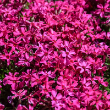
Vibrant reddish pink blooms. Evergreen. Groundcover. Native. USDA 2-9

Height: 10 inches
Spacing: 16 inches
Sunlight: partial shade, full shade
Hardiness Zone: 4a
Other Names: Woodland Phlox, Phlox divaricata subsp. laphamii
Description:
A choice variety with overlapping petals of passionate deep blue fragrant flowers that bloom in mid to late spring; a wonderful plant for borders and edging; not prone to mildew, and grows best in slightly dry conditions
Ornamental Features:
Chattahoochee Phlox is smothered in stunning lightly-scented royal blue star-shaped flowers with violet eyes at the ends of the stems from mid to late spring. Its narrow leaves remain dark green in color throughout the season.
Landscape Attributes:
Chattahoochee Phlox is a dense herbaceous perennial with a mounded form. Its relatively fine texture sets it apart from other garden plants with less refined foliage.
This plant will require occasional maintenance and upkeep, and should be cut back in late fall in preparation for winter. Deer don't particularly care for this plant and will usually leave it alone in favor of tastier treats. Gardeners should be aware of the following characteristic(s) that may warrant special consideration:
- Spreading
Chattahoochee Phlox is recommended for the following landscape applications:
- Mass Planting
- Border Edging
- General Garden Use
- Groundcover
Planting & Growing:
Chattahoochee Phlox will grow to be about 10 inches tall at maturity, with a spread of 18 inches. When grown in masses or used as a bedding plant, individual plants should be spaced approximately 16 inches apart. Its foliage tends to remain low and dense right to the ground. It grows at a fast rate, and under ideal conditions can be expected to live for approximately 10 years. As an herbaceous perennial, this plant will usually die back to the crown each winter, and will regrow from the base each spring. Be careful not to disturb the crown in late winter when it may not be readily seen!
This plant does best in partial shade to shade. It does best in average to evenly moist conditions, but will not tolerate standing water. It is not particular as to soil type or pH. It is quite intolerant of urban pollution, therefore inner city or urban streetside plantings are best avoided, and will benefit from being planted in a relatively sheltered location. Consider applying a thick mulch around the root zone over the growing season to conserve soil moisture. This is a selection of a native North American species. It can be propagated by division; however, as a cultivated variety, be aware that it may be subject to certain restrictions or prohibitions on propagation.
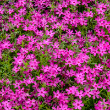
Height: 4 inches
Spacing: 15 inches
Sunlight: full sun, partial shade
Hardiness Zone: 2a
Other Names: Creeping Phlox
Description:
This variety produces a showy display of bright rosy red flowers and has a medium fast growth rate; prune lightly after flowering to encourage a dense growth habit; wonderful for rock gardens, edging, or in mixed containers;
Ornamental Features:
Crimson Beauty Moss Phlox is smothered in stunning cherry red star-shaped flowers at the ends of the stems from early to late spring. Its tiny needle-like leaves remain forest green in color throughout the year.
Landscape Attributes:
Crimson Beauty Moss Phlox is a dense herbaceous evergreen perennial with a ground-hugging habit of growth. It brings an extremely fine and delicate texture to the garden composition and should be used to full effect.
This plant will require occasional maintenance and upkeep, and should only be pruned after flowering to avoid removing any of the current season's flowers. Deer don't particularly care for this plant and will usually leave it alone in favor of tastier treats. Gardeners should be aware of the following characteristic(s) that may warrant special consideration:
- Spreading
Crimson Beauty Moss Phlox is recommended for the following landscape applications:
- Mass Planting
- Rock/Alpine Gardens
- Border Edging
- General Garden Use
- Groundcover
Planting & Growing:
Crimson Beauty Moss Phlox will grow to be only 4 inches tall at maturity, with a spread of 18 inches. When grown in masses or used as a bedding plant, individual plants should be spaced approximately 15 inches apart. Its foliage tends to remain low and dense right to the ground. It grows at a medium rate, and under ideal conditions can be expected to live for approximately 10 years. As an evegreen perennial, this plant will typically keep its form and foliage year-round.
This plant does best in full sun to partial shade. It prefers dry to average moisture levels with very well-drained soil, and will often die in standing water. It is considered to be drought-tolerant, and thus makes an ideal choice for a low-water garden or xeriscape application. It is not particular as to soil type, but has a definite preference for alkaline soils. It is highly tolerant of urban pollution and will even thrive in inner city environments. Consider covering it with a thick layer of mulch in winter to protect it in exposed locations or colder microclimates. This is a selection of a native North American species. It can be propagated by division; however, as a cultivated variety, be aware that it may be subject to certain restrictions or prohibitions on propagation.

Rich purple blooms. Early bloomer. Evergreen. Groundcover. USDA 3-8
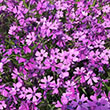
Fragrant purple blooms. Evergreen. Groundcover. Native. USDA 2-9

Attractive groundcover. Canary yellow starry flowers in spring. USDA 3-9
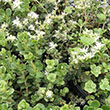
White blooms. Spreading succulent foliage. Native. USDA 4-8
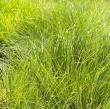
Height: 6 inches
Spread: 18 inches
Sunlight: partial shade full shade
Hardiness Zone: 3a
Description:
A weeping, perennial native sedge that forms graceful, mounded tufts of very fine textured, deep green, threadlike foliage; thrives in dry to mesic woods and does best with some shade; perfect for massing, slopes, or as a shade groundcover
Ornamental Features:
Appalachian Sedge is primarily valued in the garden for its cascading habit of growth. Its attractive threadlike leaves remain forest green in color throughout the season.
Landscape Attributes:
Appalachian Sedge is an herbaceous perennial grass with a shapely form and gracefully arching stems. It brings an extremely fine and delicate texture to the garden composition and should be used to full effect.
This is a relatively low maintenance plant, and is best cleaned up in early spring before it resumes active growth for the season. It has no significant negative characteristics.
Appalachian Sedge is recommended for the following landscape applications:
- Mass Planting
- Rock/Alpine Gardens
- Border Edging
- Groundcover
- Naturalizing And Woodland Gardens
- Container Planting
Planting & Growing:
Appalachian Sedge will grow to be only 6 inches tall at maturity, with a spread of 18 inches. Its foliage tends to remain low and dense right to the ground. It grows at a medium rate, and under ideal conditions can be expected to live for approximately 10 years. As an herbaceous perennial, this plant will usually die back to the crown each winter, and will regrow from the base each spring. Be careful not to disturb the crown in late winter when it may not be readily seen!
This plant does best in partial shade to shade. It prefers to grow in average to dry locations, and dislikes excessive moisture. It is considered to be drought-tolerant, and thus makes an ideal choice for a low-water garden or xeriscape application. This plant should not require much in the way of fertilizing once established, although it may appreciate a shot of general-purpose fertilizer from time to time early in the growing season. It is not particular as to soil type or pH. It is somewhat tolerant of urban pollution. This species is native to parts of North America. It can be propagated by division.
Appalachian Sedge is a fine choice for the garden, but it is also a good selection for planting in outdoor pots and containers. It is often used as a 'filler' in the 'spiller-thriller-filler' container combination, providing a canvas of foliage against which the thriller plants stand out. Note that when growing plants in outdoor containers and baskets, they may require more frequent waterings than they would in the yard or garden.
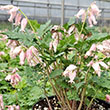
Cherry red heart shaped blooms. Grayish-green foliage. USDA 3-9
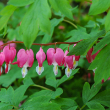
Height: 3 feet
Spacing: 30 inches
Sunlight: partial shade full shade
Hardiness Zone: 1b
Other Names: Old Fashioned Bleeding Heart
Description:
Bushy upright mounded selection features blue-green fern-like foliage and arching stems of heart shaped locket flowers with white protruding petals; excellent for shaded borders and beds; beautiful cut flower; goes into summer dormancy
Ornamental Features:
Common Bleeding Heart features delicate nodding pink heart-shaped flowers with white tips dangling from the stems from late spring to early summer. Its ferny compound leaves remain bluish-green in color throughout the season.
Landscape Attributes:
Common Bleeding Heart is an herbaceous perennial with a mounded form. Its relatively fine texture sets it apart from other garden plants with less refined foliage.
This plant will require occasional maintenance and upkeep, and should be cut back in late fall in preparation for winter. It is a good choice for attracting butterflies to your yard, but is not particularly attractive to deer who tend to leave it alone in favor of tastier treats. It has no significant negative characteristics.
Common Bleeding Heart is recommended for the following landscape applications:
- Mass Planting
- General Garden Use
- Planting & Growing
Common Bleeding Heart will grow to be about 3 feet tall at maturity, with a spread of 3 feet. When grown in masses or used as a bedding plant, individual plants should be spaced approximately 30 inches apart. It grows at a medium rate, and under ideal conditions can be expected to live for approximately 15 years. As an herbaceous perennial, this plant will usually die back to the crown each winter, and will regrow from the base each spring. Be careful not to disturb the crown in late winter when it may not be readily seen! As this plant tends to go dormant in summer, it is best interplanted with late-season bloomers to hide the dying foliage.
This plant does best in partial shade to shade. It prefers to grow in average to moist conditions, and shouldn't be allowed to dry out. It is not particular as to soil pH, but grows best in rich soils. It is somewhat tolerant of urban pollution. Consider applying a thick mulch around the root zone over the growing season to conserve soil moisture. This species is not originally from North America. It can be propagated by division.
29 found, showing page 1 of 2














